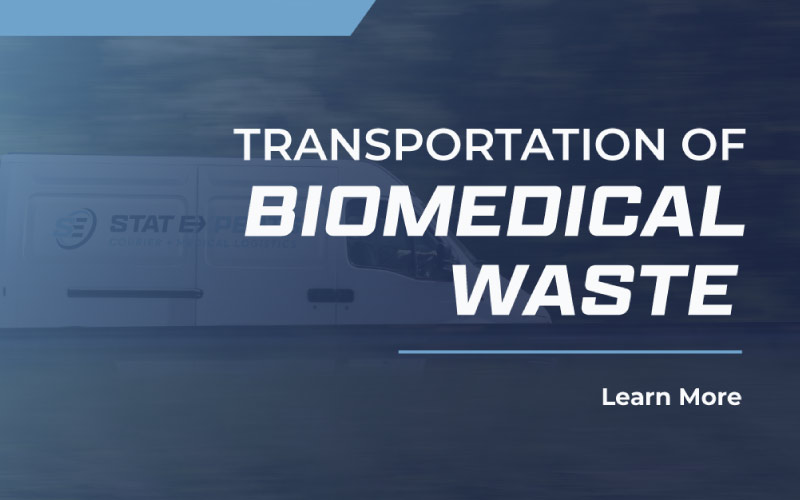Transporting biomedical waste is an intricate process, and rightfully so. Biomedical waste must be packaged, handled, transported, treated, and disposed of correctly to eliminate any risk of hazardous materials pollution. If not handled correctly, these dangerous materials can cause serious environmental and life-threatening or fatal human health effects.
How to Package and Handle Biomedical Waste
The first step to properly transporting waste is properly packaging it. Before transporting the regulated medical waste, you must appropriately and securely package it in a specially-designed reusable container or a corrugated box.
- Biomedical Waste Reusable Containers: These containers are highly sturdy polyethylene plastic receptacles that retain fumes and liquids and prevent needle penetration.
- Corrugated Boxes: These reinforced boxes have a more durable design than standard cardboard boxes for containing biomedical waste.
You must line all your containers with a red biohazard bag, overlapping all four outer sides. You can not dispose of all biomedical waste together; Therefore, your trained staff must know how to separate specific types of waste.
Some items such as medications, needles, scalpels, recycling, and regular trash cannot be thrown away in a red bag. You must contain needles and other sharp objects in puncture-proof containers before disposal.
Other medical waste, including chemotherapy and pathological waste, must be thrown away separately because these types of waste cannot be disposed of in a sewer.
Handling infectious substances properly is extremely important for the health of individuals. So, when taking out biohazardous waste, personnel must wear gloves and avoid skin contact.
If a zip tie or tap is necessary to secure the bag, you can also use this in addition to knotting the bag. Once tied, close the container, ensuring the red bag is not visible. If the red bag is visible, transportation will deny pickup. For corrugated boxes, use packing tape to secure the package. If using a reusable container, secure the container using the container’s locking mechanism. Finally, label the box according to federal, state, and local requirements.
Transporting Biomedical Waste
Hazardous waste transportation occurs in the same type of truck as any other transit because biomedical waste is already securely packaged. However, your shipment partner should ensure that their vehicles are locked if the truck is not being loaded or unloaded.
When handling hazardous materials, it is essential to partner with an experienced and professional medical logistics company. Stat Experts is a reliable and diligent logistics company specializing in medical logistics, handling freight from live organs and biopsies to biomedical and pharmaceutical waste. Our staff at Stat Experts will handle your cargo with utmost care and attention while offering efficient and stat transportation services.
Types of Biomedical Waste Treatment
Biomedical waste must first be treated to be disposed of. There are various forms of biomedical waste treatment. These forms include:
Autoclave Sterilization:
This form kills microorganisms through steam sterilization. After sterilization, this waste will be disposed of in a landfill. About 90% of biomedical waste is disposed of this way.
Incineration:
This quick and easy method can cause hazardous emissions. Therefore, before proceeding with this form of disposal, waste must be considered safe to burn.
Chemical Disinfection:
This is a standard treatment used for liquid waste. Commonly, chlorine is added to the waste to disinfect by killing microorganisms and pathogens. This process can also disinfect solid waste if it is ground before disinfection. After disinfection occurs, waste is disposed of in the sewer system.
Dangers of Improper Transportation of Biomedical Waste
If biomedical waste does not undergo these proper transportation and handling processes, it can become a serious hazard to our health and environment. Waste can contaminate air, water, and soil if not treated correctly.
These pollutants cause serious health effects for exposed humans while also harming marine and wildlife. Health effects can range from permanent disabilities to life-threatening or fatal diseases. For example, contaminated water can cause Cholera, Dysentery, or Leptospirosis epidemics within a community, and contaminated soil can diminish food production and contaminate produce.
Safely Handling Your Biomedical Waste with Stat Experts
We at Stat Experts are committed to offering our customers safe, reliable, and customized medical transportation. Contact us today so we can become a part of your team, helping you ensure appropriate biomedical waste packaging, transportation, and disposal.


